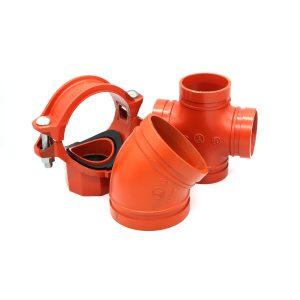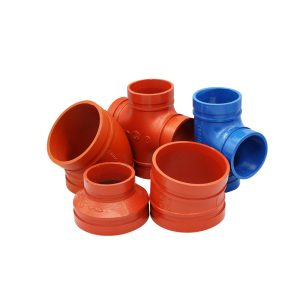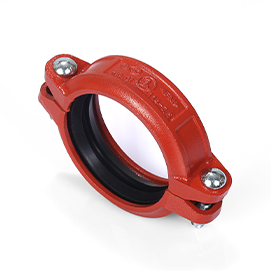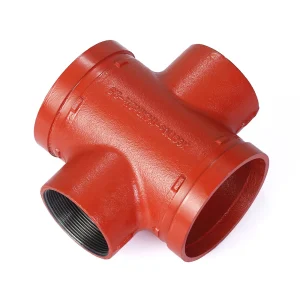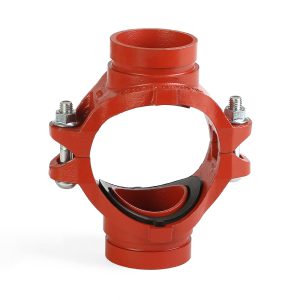
Hey there, if you’re knee-deep in piping systems—maybe designing an HVAC setup for a high-rise or sorting out fire protection in a factory—you know picking the wrong fitting can spell trouble. Leaks, failures, or just plain inefficiency. That’s where mechanical crosses come in, those handy four-way connectors that branch pipes without a fuss. But not all are created equal. Today, we’re diving into pressure ratings and materials, the real meat of choosing the right mechanical cross for your application. Stick around; we’ll break it down step by step, with some real-world tips thrown in to keep things practical.
What Exactly Is a Mechanical Cross?
Let’s start simple. A mechanical cross is basically a pipe fitting that lets you connect four pipes at right angles, creating branches in your system. Unlike welded joints, these are grooved or threaded, so installation’s a breeze—no torches or heavy equipment needed. You just clamp them on, and boom, you’re good.
In my experience working on industrial sites, these fittings shine in places like commercial buildings or processing plants where downtime costs a fortune. They’re designed for quick assembly, but the key is matching them to your system’s demands. Get it wrong, and you might end up with a burst line during a pressure surge. No fun.
Vicast, for instance, offers models like their grooved mechanical cross (XGQT18) and the threaded version (XGQT18S). These cover sizes from 2 to 10 inches—DN50 to DN250 if you’re metric-minded—and handle temps from -20°F to 180°F. That’s -29°C to 82°C for the rest of us. Pretty versatile, right?
Why Pressure Ratings Matter So Much
Pressure ratings aren’t just numbers on a spec sheet; they’re your safety net. They tell you the maximum pressure the fitting can handle without giving way. Think about it: in a fire suppression system, pressures can spike to 300 psi or more during activation. If your mechanical cross is rated lower, you’re asking for disaster.
Most standards, like AWWA C606 or ISO 6182, guide these ratings. For Vicast’s fittings, they’re built to hold up under those guidelines. Take their grooved mechanical cross—it’s engineered for high-pressure environments, but always check the exact rating for your size. Smaller diameters might top out higher than larger ones due to wall thickness.
Here’s a quick table to show how pressure ratings can vary by size for a typical ductile iron mechanical cross:
| Size (inches) | Max Working Pressure (psi) | Burst Pressure (psi) |
| 2 | 300 | 900 |
| 4 | 250 | 750 |
| 6 | 225 | 675 |
| 8 | 200 | 600 |
| 10 | 175 | 525 |
(Data based on standard ductile iron fittings; always verify with manufacturer specs.)
I’ve seen projects where folks skimped on ratings to save a buck, only to face costly retrofits. Like this one warehouse retrofit in Texas— they went with underrated crosses, and a minor pump issue turned into a flood. Lesson learned: factor in surges, not just steady-state pressure. And don’t forget temperature effects; heat can drop ratings by 10-20% in some materials.
Diving into Materials: The Backbone of Durability
Materials are where things get interesting. The right one keeps corrosion at bay and ensures longevity. Most mechanical crosses are made from ductile iron, which strikes a balance between strength and flexibility. Vicast uses ASTM A536 Grade 65-45-12 or ASTM A395 Grade 65-45-15—tough stuff that resists cracking under stress.
Why ductile iron? It’s got that nodular graphite structure, making it less brittle than cast iron. In corrosive environments, like chemical plants, you might opt for coatings or even stainless steel variants, but for standard apps, ductile does the trick. It’s recyclable too, which is a nice bonus if you’re going green.
But hey, not every job’s the same. In potable water systems, you need materials that won’t leach contaminants. Or in coastal areas, salt air demands extra corrosion resistance—maybe epoxy-coated ductile iron.
Bullet points on common materials and their pros/cons:
- Ductile Iron (ASTM A536): Strong, cost-effective. Great for HVAC and fire systems. Downside? Can rust if uncoated.
- Malleable Iron: More flexible for threaded crosses. Handles vibrations well in industrial setups.
- Stainless Steel: Pricey but unbeatable in harsh chemicals. Think food processing or marine applications.
- Carbon Steel: Lightweight option for low-pressure lines, but watch for oxidation.
From what I’ve gathered over years in the field, skipping the material match is a rookie mistake. Picture a brewery line: wrong material, and you get contamination. Or worse, in oil and gas, a failure could mean shutdowns costing thousands per hour.
Matching the Mechanical Cross to Your Specific Application
Now, let’s tie it together. Choosing the right mechanical cross for your application boils down to asking: What’s the environment? What’s the fluid? How much pressure and temp fluctuation?
For HVAC: Go grooved for easy maintenance. Vicast’s XGQT18 handles the moderate pressures (up to 300 psi) and temps in chilled water loops. In a hospital retrofit I consulted on, switching to grooved crosses cut install time by half—no welding fumes in patient areas.
Fire protection? Threaded might suit if you need precise alignment. The XGQT18S from Vicast fits right in, with its leak-proof design under surge conditions. Data from industry reports shows grooved systems reduce leak risks by 30% over threaded in high-vibe spots.
Industrial systems vary wildly. In a power plant, high temps call for materials with better heat resistance. Always cross-check with standards like GB 5135.11.
A tip: Simulate your setup. Use software to model pressures, or even prototype. It’s saved my bacon more than once on tight-deadline jobs.
Oh, and a quick aside—ever notice how these fittings evolve? Back in the ’80s, options were limited. Now, with advances like precision grooving, they’re more reliable than ever. Keeps the industry exciting.
Real-World Considerations: Beyond the Basics
Don’t overlook installation. A top-rated cross fails if installed wrong. Torque those bolts evenly; Vicast specs call for specific values to avoid gasket crush.
Maintenance matters too. In dusty factories, check grooves quarterly. And for longevity, consider the whole system—pipes, valves, everything.
Costs? Higher-rated materials add up-front expense but save long-term. A study from the American Society of Mechanical Engineers pegged failure-related downtime at $50,000 per incident in manufacturing. Worth the investment.
I’ve chatted with engineers who swear by pre-testing batches. Grab a sample, pressure-test it to burst. Gives peace of mind.
Vicast: Your Go-To Supplier for Mechanical Crosses
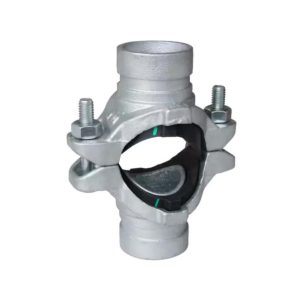
If you’re hunting for reliable options, look at Vicast. Founded back in 1982 as part of Hebei Jianzhi Foundry Group, they’ve got over 40 years cranking out pipe fittings. Their plant sprawls over a million square meters, with 4,500 folks on staff, including 350 engineers. They’re big on quality—ISO 9001 certified—and they’ve snagged over 200 patents. Vicast’s mechanical crosses, like the grooved and threaded models, are built for HVAC, fire, and industrial use, meeting global standards. They’ve supplied landmarks from Beijing’s Olympic venues to high-rises across China. Plus, they’re eco-focused, using up to 98% recycled materials in their ductile iron. If you need custom solutions, they’re game.
Conclusion
Wrapping this up, nailing the pressure ratings and materials when choosing the right mechanical cross for your application isn’t rocket science—it’s smart engineering. Get the basics right, factor in your setup’s quirks, and you’ll avoid headaches down the line. Whether it’s a simple branch or a complex network, the payoff’s in reliability and efficiency. Ready to spec your next project? Dive into those details; it’ll make all the difference.
FAQs
What are the key pressure ratings to consider when choosing the right mechanical cross for your application?
Pressure ratings indicate the max load a cross can take. For Vicast’s grooved models, they often hit 300 psi for smaller sizes, dropping a bit for larger ones. Always match to your system’s peaks, including surges, and check standards like AWWA C606.
How do materials impact the choice of a mechanical cross?
Materials like ductile iron (ASTM A536) offer strength and corrosion resistance for most apps. In choosing the right mechanical cross for your application, think about fluids—water, chemicals?—and environment. Vicast’s options are tough, but stainless might be needed for aggressive settings.
Can temperature affect pressure ratings in mechanical crosses?
Absolutely. Temps from -20°F to 180°F are standard for Vicast fittings, but heat can lower ratings. When choosing the right mechanical cross for your application, factor in fluctuations to prevent failures.
What’s the difference between grooved and threaded mechanical crosses?
Grooved, like Vicast’s XGQT18, clamp on quick for easy installs. Threaded (XGQT18S) offer precise fits but take more time. Pressure ratings and materials are similar, so pick based on your application’s access and vibe levels.
How can I ensure long-term performance from my mechanical cross?
Regular checks, proper install, and matching pressure ratings and materials to your needs. In real projects, this cuts risks big time. Vicast’s durable builds help, but maintenance is key.

